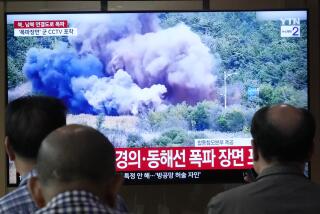Hyundai Shutdown Sparks Korean Clash
- Share via
SEOUL, South Korea — The giant Hyundai combine, South Korea’s No. 1 auto maker, shut down six industrial plants Monday, touching off labor violence in the southern city of Ulsan.
An estimated 20,000 workers broke into the compound of the Hyundai shipbuilding subsidiary, the nation’s largest, smashing through the main-gate guardhouse. The gate itself had been blocked by company officials, who used a crane to place a 1,000-ton section of a ship’s hull in front of it.
Later, in heavy rain, about 1,000 workers left the yard and, hurling rocks and bottles, tried to march on the center of Ulsan, according to press reports. They were turned back by riot police firing tear gas.
More Inclusive Union
The step taken by Hyundai, which shut down all the conglomerate’s major operations for an indefinite period, marked a new level of conflict in the labor strife that has crippled South Korean industry in the last few weeks. For the first time, organizers were pushing for recognition of a labor union representing all workers of an industrial group.
Hyundai officials charged that the prospective group-wide union was formed illegally and insisted that pro-company unions were already established at all Hyundai subsidiaries. The specific reason given for Monday’s action, however, was to protect company property and what officials said was a majority of workers who opposed the new union, which was formed late last week.
The plants shut down Monday produce heavy machinery, ships, precision tools and electrical and wood products. Hyundai Motor Co., producer of the Excel subcompact car that is exported to the United States, was closed last week. Officials said production could not continue because labor disputes had disrupted supplies for its assembly line. Daewoo Motor Co., the country’s No. 2 auto maker in which General Motors owns a 50% share, also shut down last week and failed to reopen Monday because of a lack of parts.
The developments at Hyundai took place as the nationwide labor strife showed signs of easing. The Labor Ministry said the number of disputes resolved over the weekend exceeded new walkouts for the first time in three weeks. However, the number of work sites still plagued by labor disputes remains high. The ministry put the figure at 280.
The strikes began in early June, in tandem with anti-government demonstrations calling for political reform. When the government party agreed in late June to meet the major opposition demands, the walkouts accelerated.
Many business leaders blame unionists who, management says, are former student radicals who left university campuses to infiltrate the labor movement. Other analysts said the walkouts were sparked by the promise of political reform.
Nearly all politicians and analysts, including those of the ruling party, which supported management with tough anti-strike regulations in the past, agree that the blue-collar worker deserves a greater share of South Korea’s growing economy.
The central Bank of Korea reported Monday that economic growth increased by 15% in the second quarter, bringing first-half growth to 15.3% compared with 1986. But the labor disputes have hit hard at export industries, and if they continue, the real growth rate could be slowed.
Violent disputes that disrupted the critical coal industry ebbed Monday. More than 1,000 miners returned to work, and 30 of the 35 mining companies shut down or slowed by labor trouble last week were back in operation.
More to Read
Sign up for Essential California
The most important California stories and recommendations in your inbox every morning.
You may occasionally receive promotional content from the Los Angeles Times.













